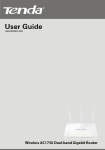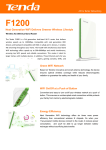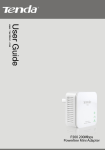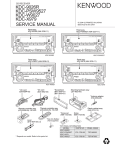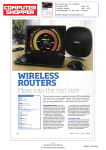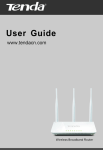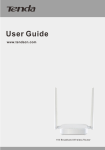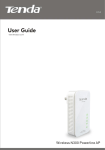Download Tenda W900U
Transcript
150M 便携式 3G 无线路由器 Wireless AC Dual-band USB Adapter Copyright Statement is the registered trademark of Shenzhen Tenda Technology Co., Ltd. All the products and product names mentioned herein are the trademarks or registered trademarks of their respective holders. Copyright of the whole product as integration, including its accessories and software, belongs to Shenzhen Tenda Technology Co., Ltd. Without prior expressed written permission from Shenzhen Tenda Technology Co., Ltd, any individual or party is not allowed to copy, plagiarize, reproduce, or translate it into other languages. All photos and product specifications mentioned in this manual are for references only. Upgrades of software and hardware may occur; Tenda reserves the right to revise this publication and to make changes in the content hereof without obligation to notify any person or organization of such revisions or changes. If you would like to know more about our product information, please visit our website at http://www.tendacn.com. 2 Wireless AC Dual-band USB Adapter Table of Contents Copyright Statement .............................................................................2 Table of Contents.....................................................................................3 Chapter 1 Product Overview .............................................................5 1.1 Package Contents (For references only).................................................................. 5 1.2 LED Overview .................................................................................................................... 5 1.3 Key Features ....................................................................................................................... 5 1.4 Applications........................................................................................................................ 6 1.5 Before Getting Started ..................................................................................................... 6 1.6 Maintenance ....................................................................................................................... 7 Chapter 2 Installation Guide...............................................................8 2.1 Hardware Install ............................................................................................................... 8 2.2 Software Install .................................................................................................................. 9 Chapter 3 Use System Built-in Wireless Utility ....................... 15 3 Wireless AC Dual-band USB Adapter 3.1 Connect to a Wireless Network --Windows® XP .............................................. 15 3.2 Connect to a Wireless Network --Windows® 7 ................................................. 18 3.3 Connect to a Wireless Network --Windows® 8 ................................................. 20 Chapter 4 Tenda UI Guide ................................................................ 23 4.1 Frequency Band Setup ................................................................................................ 23 4.2 Wireless Connection..................................................................................................... 24 4.3 Wireless Status ................................................................................................................ 26 4.4 Network Profile .............................................................................................................. 27 4.5 WPS Settings.................................................................................................................... 34 4.6 Help ..................................................................................................................................... 45 Appendix 1 Config TCP/IP settings on your PC ..................... 46 Appendix 2 Glossary .......................................................................... 53 Appendix 3 FAQs ................................................................................. 56 Appendix 4 EMC Statement ............................................................ 58 4 Wireless AC Dual-band USB Adapter Chapter 1 Product Overview The Tenda W900U Wireless AC900 Dual Band Adapter based on IEEE 802.11ac technology delivers next generation WiFi speeds. The device enables multiple HD video streams throughout your home simultaneously. With speed up to 867Mbps (5G) + 300Mbps (2.4G) and dual band technology, the W900U effectively avoids interference, ensuring top WiFi speeds and reliable connections. Unique design makes it easy to use with both laptops and desktops. Plus, securing a wireless connection is fast and simple at a push of the WPS button. The W900U is perfect for upgrading your existing laptop or desktop to 802.11ac. 1.1 Package Contents (For references only) Tenda W900U Wireless AC900 Dual Band Adapter CD (with driver and user manual) 1.2 LED Overview The adapter comes with a status LED, which displays: a) b) a green light while identified and functioning properly. a blue light while transferring data, which blinks faster at a higher speed (the higher the speed is, the faster it blinks). 1.3 Key Features 5 Wireless AC Dual-band USB Adapter Automatically sense network and adjust transmission rate 20/40M for 2.4G;20/40/80M for 5G Comes with 2 operating modes: Infrastructure and Ad-Hoc Access secure networks using WEP, WPA or WPA2 Wi-Fi Protected Setup™ (WPS) for easy connection to a wireless network Compatible with Windows XP, Vista, Windows7, Windows8 and more 1.4 Applications The Tenda adapter delivers powerful, fast and reliable wireless access to your desktop or notebook computer. It is ideal for use by or in: corporate staff who want to stay connected to Internet while moving around ancient buildings, places rented or for temporary use where wiring is business or individual always in need of network topology changes business or individual who wants to have a wireless network such a big mess, a huge cost or hard to reach established fast and simple without the mess of wiring 1.5 Before Getting Started Before installing and using this product, please peruse the entire user guide. a) If you have a built-in wireless adapter, please disable it in Device Manager before installing this Tenda adapter. b) Also, if you have previously installed a different manufacturer's 6 Wireless AC Dual-band USB Adapter adapter or a different model Tenda adapter, make sure the software and driver are uninstalled before installing the new software. Some utilities may cause a conflict with the new software. 1.6 Maintenance Observe the following to ensure the product continuously stays in good Keep the device away from humidity and water DO NOT expose the device to corrosive substances (such as acid and alkali, etc) DO NOT expose the device to sunshine or other heat sources Contact Tenda technical staff if you are running into problems that you are not able to solve 7 Wireless AC Dual-band USB Adapter Chapter 2 Installation Guide The CD that comes in the package includes both driver and software, which can be installed automatically. This section will walk you through the installation process. Software install and operation instructions are illustrated in Windows® XP. If you have a different operating system, the screenshots on your computer will look similar to the following examples. 2.1 Hardware Install Turn on your computer and insert the Tenda adapter into an available USB port on your computer. 8 Wireless AC Dual-band USB Adapter 2.2 Software Install 1. If the Found New Hardware Wizard appears, click Cancel and then use the quick install CD to install the driver and software. 2. Insert the Tenda Driver CD in your PC's CD-ROM driver. If the CD Autorun function does not automatically start on your computer, double click Tenda.exe. When the autorun screen appears, click Run. 9 Wireless AC Dual-band USB Adapter 3. Select the language you want to use and click Next to continue. 10 Wireless AC Dual-band USB Adapter 4. Check I accept the terms of the license agreement and then click Next. 5. You can either install the standalone driver without Tenda adapter utility or install both driver and Tenda adapter utility. 11 Wireless AC Dual-band USB Adapter Note: If you wish to use Windows system built-in wireless utility, you can select the first installation mode; however, if you want to use advanced features like WPS, you must also install the Tenda adapter utility. 12 Wireless AC Dual-band USB Adapter 6. Click Install to install the driver. 13 Wireless AC Dual-band USB Adapter 7. Wait till the driver is completely auto-installed and then click Finish to exit. 14 Wireless AC Dual-band USB Adapter Chapter 3 Use System Built-in Wireless Utility This section will walk you through the configuration process of connecting to a wireless network using your PC's OS built-in wireless utility. To use Windows XP built-in wireless utility, you must first enable the Wireless Zero Configuration service (enabled by default). 3.1 Connect to a Wireless Network --Windows® XP 1. Right-click My Network Places from the desktop and select Properties. 15 Wireless AC Dual-band USB Adapter 2. As seen below, Wireless Network Connection displays Not Connected. Right click Wireless Network Connection and select View Available Wireless Networks. 3. The utility will display any available wireless networks in your area. If you don't see the network you wish to connect to, click the Refresh network list. Click on the network (SSID) you wish to connect to and click the Connect button or directly double click it. If you are prompted to provide a security key, simply enter it (case sensitive) exactly as it is on your wireless router or access point and then click Connect. 16 Wireless AC Dual-band USB Adapter Note: If the network you selected is not encrypted, you will not see this dialog box requesting a security key. 4. When this screen appears, you have successfully connected to your wireless network and can start surfing Internet. 17 Wireless AC Dual-band USB Adapter 3.2 Connect to a Wireless Network --Windows® 7 1. Click the wireless icon in your system tray (lower-right corner). The utility will display any available wireless networks in your area. Click on a network (SSID) and click the Connect button or directly double-click it. If you don't find the desired wireless network, click the refresh icon (upper-right corner) to update the list. 2. If you are prompted to provide a security key, simply enter it exactly as it is on your wireless router or access point and then click OK. 18 Wireless AC Dual-band USB Adapter 3. When Connected appears next to the selected wireless network (SSID), you have successfully connected to it. To disconnect from it, view status, or change wireless properties, etc, simply right-click the SSID. 19 Wireless AC Dual-band USB Adapter 3.3 Connect to a Wireless Network --Windows® 8 1. Click the wireless icon in your system tray (lower-right corner). The utility will display any available wireless networks in your area. Click on a network (SSID) and click the Connect button or directly double-click it. 2. If you are prompted to provide a security key, simply enter it exactly as it is on your wireless router or access point and then click Next. 20 Wireless AC Dual-band USB Adapter 3. When Connected appears next to the selected wireless network (SSID), you have successfully connected to it. 21 Wireless AC Dual-band USB Adapter Note: If the wireless router or AP you connect to via the wireless adapter does not have Internet access, then you will get a Restricted status and a yellow exclamation mark will appear in the wireless icon in your system tray (lower-right corner). 22 Wireless AC Dual-band USB Adapter Chapter 4 Tenda UI Guide If you select Install driver and Tenda WLAN Utility, then both of them will be installed on your PC. All features on the adapter can be configured and implemented through the Tenda adapter utility (abbreviated to UI). To start the Tenda UI, select Start-> Tenda-> W900U or directly click W900U shortcut from your desktop. 4.1 Frequency Band Setup Here you can select the band for the adapter to operate on: 2.4G, 5G or concurrently both 2.4G and 5G. 23 Wireless AC Dual-band USB Adapter 4.2 Wireless Connection Wireless Connection displays all available wireless networks in the area and lets you see at a glance MAC address, channel, network mode (a/b/g/n), signal strength, authentication mode, encryption mode and/or WPS authentication of each AP. Also, you can select to connect to the desired wireless network. Before connecting to a wireless network: 1. Click Rescan to update the available wireless network list, select a desired wireless network and then click Connect. 24 Wireless AC Dual-band USB Adapter 2. If you are prompted to provide a security key, simply enter it exactly as it is on the wireless router or access point you plan to connect to and then click Next. Note: If you check Save wireless network upon successful connection, then, after the adapter connects to the network, it automatically saves the network connection information to a profile. For detailed illustrations of authentication and encryption modes, see below: WEP: Support 10 or 26 Hex characters; 5 or 13 ASCII characters. WPA-PSK: Support 8~63ASCII characters; 8~64Hex characters. WPA2-PSK: Support 8~63 ASCII characters; 8~64 Hex characters. WPA-PSK/WPA2-PSK: Support 8~63 ASCII characters; 8~64 Hex characters. Note: Hex characters include numbers of 0~9 and letters of a~f. ASCII characters include any alphanumeric characters. 25 Wireless AC Dual-band USB Adapter 4.3 Wireless Status After you have successfully connected to a wireless network, you can click Wireless Status to view details of the connection, including SSID, MAC address, authentication mode, encryption mode, channel, signal strength, transmission rate of the connected AP, IP address assigned to the adapter, subnet and TX/RX packet statistics, etc. 26 Wireless AC Dual-band USB Adapter 4.4 Network Profile Also, you can manually add a profile to connect to a specified wireless network. After the adapter joins the network, it automatically saves the network connection information to a profile, which can be used by adapter utility. The next time you launch adapter utility, it will automatically connect to the network you previously joined if there's no change in the network information. If you wish to join a hidden network (A hidden network does not broadcast its SSID), you must add a profile to manually connect to it. Fields on screenshot are described below: Add: Click to create a new wireless network profile. Delete: Click to remove an existing profile. Edit: Click to edit a current profile. 27 Wireless AC Dual-band USB Adapter An 802.11 wireless adapter (WNIC) can operate in two modes known as infrastructure mode and ad hoc mode: Infrastructure: In an infrastructure mode network the wireless adapter needs a wireless access point or a wireless router for communication. All wireless nodes in an infrastructure mode network connect to an access point or a wireless router. Ad-hoc: A wireless ad hoc network does not rely on a preexisting infrastructure, such as routers in wired networks or access points in managed (infrastructure) wireless networks. It typically refers to any set of networks where all devices have equal status on a network and are free to associate with any other ad hoc network device in link range in peer to peer communication mode. 28 Wireless AC Dual-band USB Adapter 4.4.1 Profile Set Up for Infrastructure Mode If you plan to connect your wireless adapter to an existing wireless AP or wireless router, please select the Infrastructure mode. Setting up infrastructure mode for wireless connectivity is not that hard, all we need is to follow below instructions: 1. Click Add and select Infrastructure from the appearing dialog box appear. 2. Specify a profile name and the SSID (wireless network name) you wish to connect. 3. Specify the authentication mode and encryption mode, say, "WPA-PSK" and "AES". 4. Enter the security key and click Save. 29 Wireless AC Dual-band USB Adapter Now, you may see the added profile in the list. You can edit or delete it. By clicking Connect, you will soon connect to the wireless network specified in the profile. Note: If you wish to join a hidden network (wireless AP or wireless router that does not broadcast its SSID), you must add a profile to manually connect to it. 30 Wireless AC Dual-band USB Adapter 4.4.2 Profile Set Up for Ad Hoc Mode By using ad hoc mode for communication, each PC must have a wireless adapter for sharing resources. Setting up the Ad Hoc is easy. Simply follow below instructions: 1. Configure a static IP address for each wireless adapter. All PCs on the Ad Hoc network must be configured with static IP addresses manually. For details, see appendix 1 hereof. 2. To add Ad Hoc profile: a) Click Add and specify a SSID (wireless network name), say, "Tenda". b) Select Ad Hoc as network type. c) Select WEP and specify a WEP key. d) Click Save .and you will find the profile in profile list. e) Select it and click Connect. 31 Wireless AC Dual-band USB Adapter f) Search the wireless network from devices on other nodes. g) Double-click it, enter a security key if required and then click Connect. 32 Wireless AC Dual-band USB Adapter When below screen appears, you have successfully connected to it. 33 Wireless AC Dual-band USB Adapter 4.5 WPS Settings If your wireless network supports WPS, you can use WPS to join a wireless network. WPS can easily and quickly create secure wireless connections. There are two ways to join a wireless network using WPS: Connect using WPS hardware button: Press the WPS button on the side of the adapter. This applies only to join a PBC encrypted wireless network; Connect using WPS PBC or PIN: Join a wireless network from the Tenda adapter utility. This applies to both PBC and PIN encrypted wireless networks. 34 Wireless AC Dual-band USB Adapter Follow instructions below: 4.5.1 To join a wireless network using WPS hardware button: 1. Enable WPS and PBC on your wireless router. (Press the WPS button on your wireless router or enable PBC from your router's management UI. For details, see the router's User Guide) . 2. Run Tenda adapter UI and press and hold the WPS button on the side of the adapter for about 2 seconds. 3. When below screen appears, you have successfully connected to it. 35 Wireless AC Dual-band USB Adapter 4.5.2 To join a wireless network using WPS PBC or PIN from adapter’s UI: 1. To join a wireless network using WPS PBC from Tenda adapter UI: Select WPS Settings-> Connect using WPS PBC or PIN. Click Next and then select PBC. 36 Wireless AC Dual-band USB Adapter Note: a) Automatically select network to connect: Automatically select a WPS-capable AP from searched results to join. This field is checked by default. If this field is left unchecked, you must manually select a WPS-capable AP to connect. b) If you want to manually select the WPS-capable AP that you wish to join, leave this field unchecked. Click Next and follow onscreen WPS instructions to enable WPS-PBC on the AP. 37 Wireless AC Dual-band USB Adapter Then within 2 minutes, enable the WPS on your wireless router and click then Next. Negotiation Process: 38 Wireless AC Dual-band USB Adapter Negotiation Completed Successfully: Now, simply click Next and you will see the SSID of the wireless network you joined. The WPS-PBC connection is now completed. 39 Wireless AC Dual-band USB Adapter 2. To join a wireless network using WPS PIN from Tenda adapter UI: Select WPS Settings-> Connect using WPS PBC or PIN. Click Next and then select PIN. 40 Wireless AC Dual-band USB Adapter Click Next and you will find two available WPS-PIN modes: 1. Enter a PIN into my Access Point or Registrar: Follow onscreen instructions to copy W900U's PIN to the wireless AP and enable WPS-PIN on the wireless AP. For example: If you wish to connect to Tenda W1800R, simply copy the PIN to Tenda W1800R and enable WPS-PIN on the Tenda W1800R. 41 Wireless AC Dual-band USB Adapter 2. Enter the PIN from my Access Point: First, enable the WPS-PIN on the wireless AP to connect, say, Tenda W1800R. 42 Wireless AC Dual-band USB Adapter Second, enter the wireless AP's PIN. And then click Next to start WPS-PIN negotiation. Negotiation Completed: 43 Wireless AC Dual-band USB Adapter Now, simply click Next and you will see the SSID of the wireless network you joined. The WPS-PIN connection is now completed. 44 Wireless AC Dual-band USB Adapter 4.6 Help Click the Help button to display help. 45 Wireless AC Dual-band USB Adapter Appendix 1 Config TCP/IP settings on your PC If you are using Windows XP, do as follows: 1. Click Start > Control Panel > Network and Internet Connections > Network Connections. 46 Wireless AC Dual-band USB Adapter 2. Right-click on the Local Area Connection and select Properties. 3. Select Internet Protocol (TCP/IP) and click Properties. 47 Wireless AC Dual-band USB Adapter 4. Select "Use the following IP address". IP address: Enter 192.168.0.xxx where xxx can be any number between 2 and 253). Subnet mask: Enter 255.255.255.0 Click OK twice to save your settings. 48 Wireless AC Dual-band USB Adapter If you are using Windows 7, do as follows: 1. Click on Start > Control Panel > Network and Internet > Network and Sharing Center. 49 Wireless AC Dual-band USB Adapter 2. Click "Change adapter settings". 3. Right-click on the Local Area Connection and select Properties. 50 Wireless AC Dual-band USB Adapter 4. Select Internet Protocol Version 4 (TCP/IPv4) and click Properties or directly double-click on Internet Protocol Version 4 (TCP/IPv4). 5. Select "Use the following IP address". 51 Wireless AC Dual-band USB Adapter IP address: Enter 192.168.0.xxx where xxx can be any number between 2 and 253). Subnet mask: Enter 255.255.255.0 Click OK twice to save your settings. 52 Wireless AC Dual-band USB Adapter Appendix 2 Glossary 802.11ac: IEEE 802.11ac is a wireless computer networking standard of 802.11, currently under development, providing high-throughput wireless local area networks on the 5 GHz band. Theoretically, this specification will enable multi-station WLAN throughput of at least 1 gigabit per second and a maximum single link throughput of at least 500 megabits per second (500 Mbit/s). 802.11a: 802.11a is an amendment to the IEEE 802.11 specification that added a higher data rate of up to 54 Mbit/s using the 5 GHz band. 802.11b: 802.11b, is an amendment to the IEEE 802.11 wireless networking specification that extends throughput up to 11 Mbit/s using the same 2.4 GHz band. 802.11e: 802.11e is an approved amendment to the IEEE 802.11 standard that defines a set of Quality of Service enhancements for wireless LAN applications through modifications to the Media Access Control (MAC) layer. The standard is considered of critical importance for delay-sensitive applications, such as Voice over Wireless LAN and streaming multimedia. 802.11g: 802.11g is an amendment to the IEEE 802.11 specification that extended throughput to up to 54 Mbit/s using the same 2.4 GHz band as 802.11b. 802.11h: 802.11h, refers to the amendment added to the IEEE 802.11 standard for Spectrum and Transmit Power Management Extensions. It solves problems like interference with satellites and radar using the same 5 GHz frequency band. It was originally designed to address European regulations but is now applicable in many other countries. 53 Wireless AC Dual-band USB Adapter 802.11i: 802.11i, implemented as WPA2, is an amendment to the original IEEE 802.11. 802.11j: 802.11j is an amendment to the IEEE 802.11 standard designed specially for Japanese market. 802.11n: 802.11n is an amendment to the IEEE 802.11 standard, which improves network throughput over the two previous standards—802.11a and 802.11g—with a significant increase in the maximum net data rate. 802.11n standardized support for multiple-input multiple-output and frame aggregation, and security improvements, among other features. IEEE 802.15: IEEE 802.15 is a working group of the IEEE 802 standards committee which specifies Wireless Personal Area Network (WPAN) standards. It includes seven task groups. Task group one is based on Bluetooth technology. IEEE 802.16: IEEE 802.16 is a series of Wireless Broadband standards authored by the Institute of Electrical and Electronics Engineers (IEEE). Although the 802.16 family of standards is officially called Wireless MAN in IEEE, it has been commercialized under the name “WiMAX” (from "Worldwide Interoperability for Microwave Access") by the WiMAX Forum industry alliance. 802.16a: 802.16a, also known as WiMAX, extends throughput up to 70Mbit/s transmission rate within the distance of 30 miles. 802.20: Delivers 1Mbit/s throughput for wireless MAN (Metropolitan area network). IEEE 802.1X: IEEE 802.1X is an IEEE Standard for port-based Network Access Control (PNAC). It is part of the IEEE 802.1 group of networking protocols. It provides an authentication mechanism to devices wishing to 54 Wireless AC Dual-band USB Adapter attach to a LAN or WLAN.IEEE 802.1X defines the encapsulation of the Extensible Authentication Protocol (EAP) over IEEE 802 which is known as "EAP over LAN" or EAPOL. WEP: Wired Equivalent Privacy (WEP) is a security algorithm for IEEE 802.11 wireless networks. Introduced as part of the original 802.11 standard, its intention was to provide data confidentiality comparable to that of a traditional wired network. WPA: Wi-Fi Protected Access (WPA) and Wi-Fi Protected Access II (WPA2) are two security protocols and security certification programs developed by the Wi-Fi Alliance to secure wireless computer networks. The Alliance defined these in response to serious weaknesses researchers had found in the previous system, WEP (Wired Equivalent Privacy) and intended as an intermediate solution to WEP insecurities. RSN: The Wi-Fi Alliance refers to their approved, interoperable implementation of the full 802.11i as WPA2, also called RSN (Robust Security Network). RSN, based on 802.1x, is introduced to supersede the security specification, WPA. 55 Wireless AC Dual-band USB Adapter Appendix 3 FAQs Q1: How do I enable the WZC (Wireless Zero Configuration) service in Windows XP or enable WAC (WLAN AutoConfig) in Win dows 7/Win dows 8? Step1. From your desktop, right-click My Computer and select Manage. Step2. Select Services and Applications -> Services. Step3. Double-click Wireless Zero Configuration/ WLAN AutoConfig and then click Start on the appearing window or right click Wireless Zero Configuration/ WLAN AutoConfig and select Start from the pop-up list. 56 Wireless AC Dual-band USB Adapter Enable WZC in Windows XP Enable WLAN AutoConfig in Windows7 Q2: I followed instructions to install the driver but failed. This can occur if you have already installed other manufacturer's adapter. Drivers of other manufacturer might cause a conflict with the new driver. Please first uninstall it and then check to make sure that oem.inf file is removed from C:\WINDOWS\inf. 57 Wireless AC Dual-band USB Adapter Appendix 4 EMC Statement CE Mark Warning This is a Class B product in a domestic environment, this product may cause radio interference, in which case the user may be required to take adequate measures. NOTE: (1) The manufacturer is not responsible for any radio or TV interference caused by unauthorized modifications to this equipment. (2) To avoid unnecessary radiation interference, it is recommended to use a shielded RJ45 cable. FCC Statement This equipment has been tested and found to comply with the limits for a Class B digital device, pursuant to part 15 of the FCC Rules. These limits are designed to pro-vide reasonable protection against harmful interference when the equipment is operate din a commercial environment. This equipment generates, uses, and can radiate radiofrequency energy and, if not installed and used in accordance with the instruction manual, may cause harmful interference to radio communications. Operation of this equipment in a residential area is likely to cause harmful interference in which case the user will be required to correct the interference at his own expense. FCC Caution: Any changes or modifications not expressly approved by the party responsible for compliance could void the user's authority to operate 58 Wireless AC Dual-band USB Adapter this equipment. This device complies with part 15 of the FCC Rules. Operation is subject to the following two conditions: (1) This device may not cause harmful interference, and (2) this device must accept any interference received, including interference that may cause undesired operation. The manufacturer is not responsible for any radio or TV interference caused by unauthorized modifications to this equipment. NOTE: (1) The manufacturer is not responsible for any radio or TV interference caused by unauthorized modifications to this equipment. (2) To avoid unnecessary radiation interference, it is recommended to use a shielded RJ45 cable. 59



























































